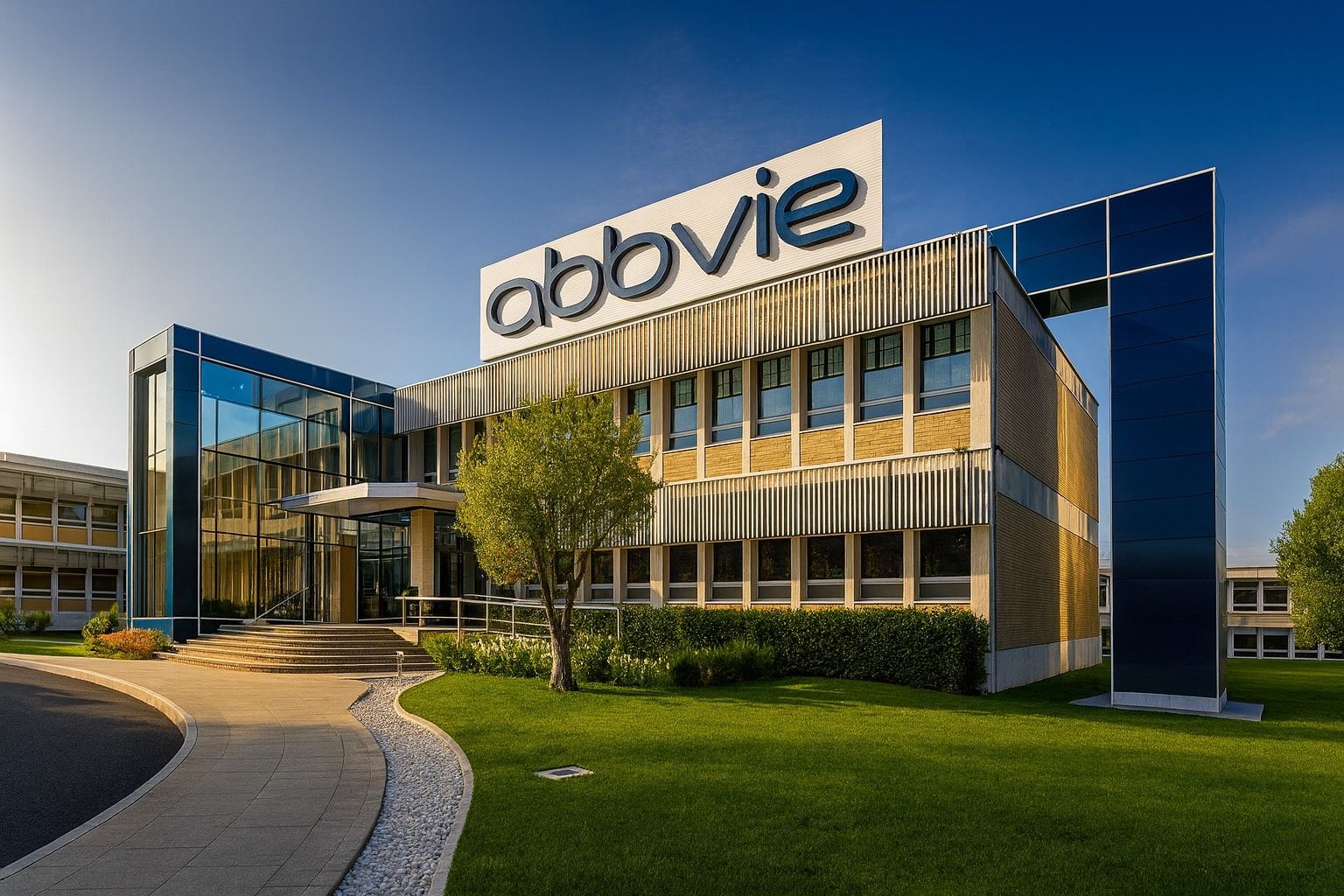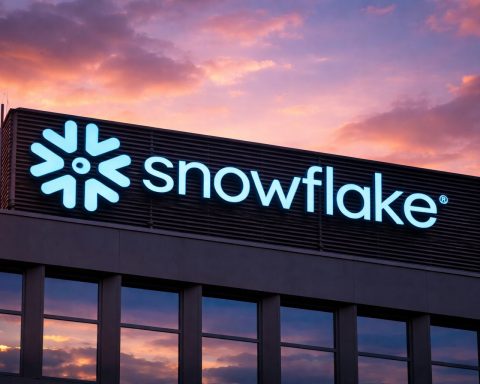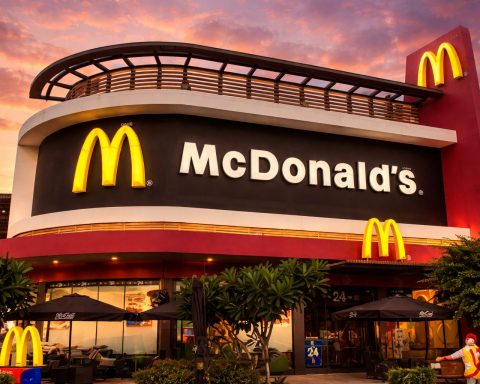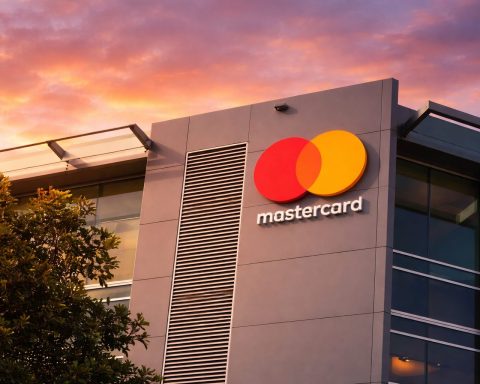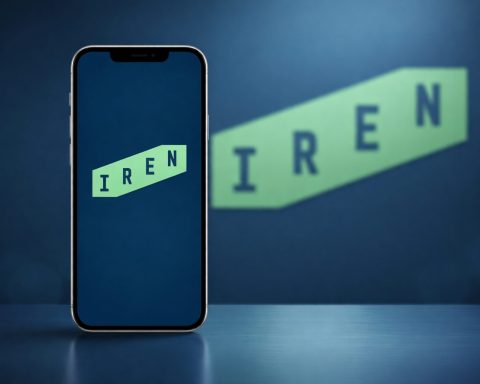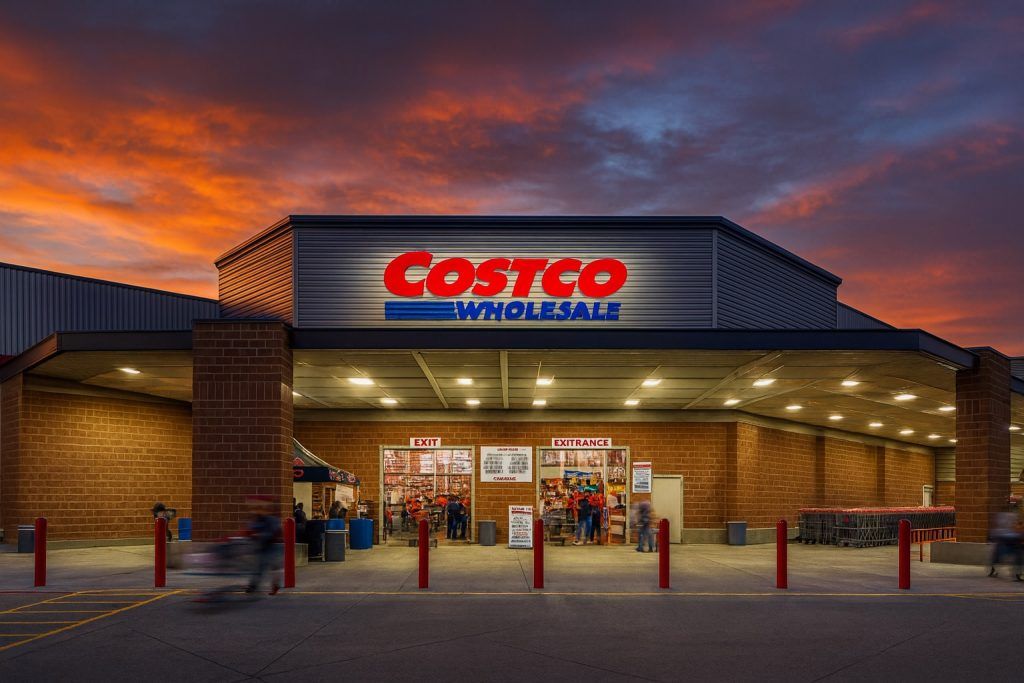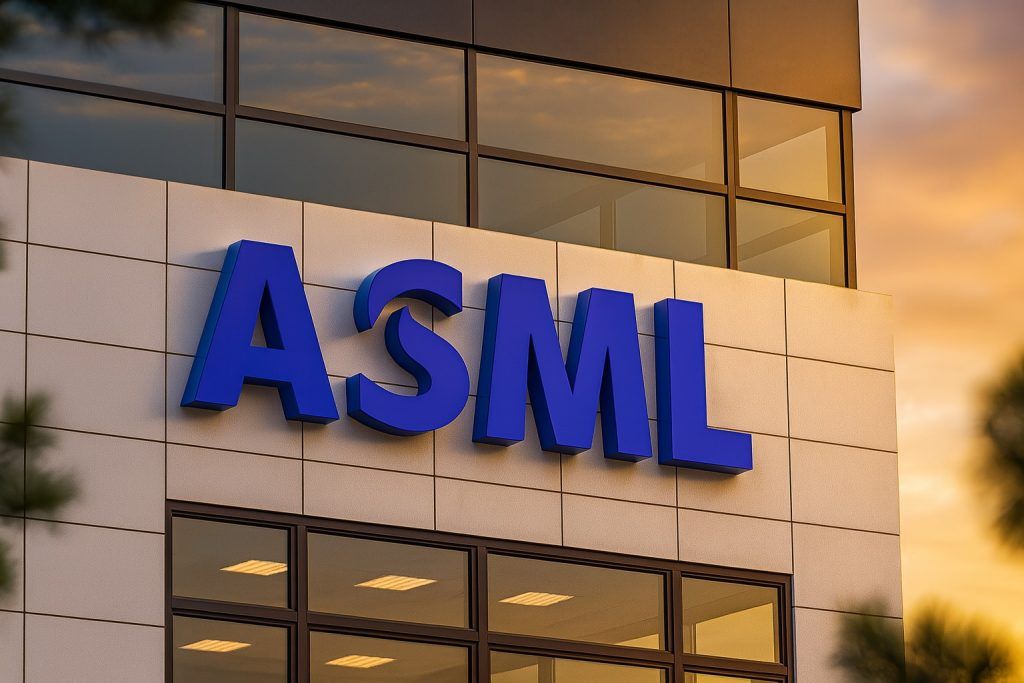Key Facts (as of Oct. 23, 2025):
- Stock Price & Performance: AbbVie stock trades around $229 per share, near the top of its 52-week range ($164.99–$244.38) after a year of ~28% gains, outperforming the broader healthcare index [1]. Shares hit a record high (~$245) in late September [2], and are up roughly 28% year-to-date, handily beating the S&P 500’s Health Care sector.
- Recent Movement: The stock has pulled back from its peak following a surprise R&D charge in early October that cut guidance (more below), but remains above key technical levels (trading above its 50- and 200-day moving averages of ~$218 and $197 [3]). The late-September rally pushed momentum into overbought territory, and subsequent consolidation has cooled indicators, leaving ABBV in a bullish trend but off highs.
- Major Developments: AbbVie secured an FDA approval on Oct. 13 expanding the use of its drug Rinvoq in inflammatory bowel diseases [4] [5]. On Oct. 20, a head-to-head trial showed Rinvoq outperformed Humira in rheumatoid arthritis [6], reinforcing confidence in AbbVie’s post-Humira pipeline. Meanwhile, earlier in the month AbbVie pre-announced a large $2.7 billion R&D write-off, prompting a cut to full-year profit forecasts [7] [8].
- Analyst Sentiment: Wall Street is broadly bullish. In just the past week, multiple analysts hiked their price targets on ABBV – e.g. Wolfe Research to $275 (Oct. 23) [9] and BMO Capital to $258 (Oct. 21) [10] – citing pipeline progress and attractive valuation. The consensus rating is a “Moderate Buy” with an average target in the mid-$230s [11], and nearly 70% of ABBV shares are held by institutions and funds [12], reflecting strong investor confidence.
- Looking Ahead: AbbVie will report Q3 2025 earnings on Oct. 31, with investors watching how Humira’s decline and new drugs offset each other. The company has already warned of a one-time R&D expense hitting Q3 earnings [13] [14]. Beyond earnings, AbbVie’s R&D pipeline (new drug filings and trial results) and any strategic moves (deals or buybacks) will be key for sustaining its momentum into 2026.
Stock Price and Recent Performance
AbbVie’s stock has been a standout in 2025. Shares currently hover around $228–$229, up roughly 28% since January and near their highest levels on record [15]. By comparison, the S&P 500 healthcare index is up only around half that, so AbbVie is outperforming its sector. The stock’s 52-week high was about $244.8 (reached on Oct. 1) [16], and its low in the past year was ~$163.8. Notably, AbbVie surged to a record high in mid-September after the company announced a patent settlement ensuring no U.S. generics for its key drug Rinvoq until 2037 [17]. That news – effectively a four-year extension of exclusivity – drove a 4% one-day jump in ABBV stock [18]. Analysts cheered the development; J.P. Morgan’s Chris Schott said the deal gives AbbVie “several more years of runway on one of its key growth drivers,” buying time to develop other drugs ahead of major mid-2030s patent losses [19]. William Blair’s Matt Phipps added it could add ~$2 billion to Rinvoq’s peak sales by protecting the franchise longer [20]. This optimism around AbbVie’s future revenue stream helped fuel the stock’s late-summer rally.
However, early October brought a reality check. On Oct. 3, AbbVie revealed it would take an unexpected $2.7 billion charge for in-process R&D in Q3, forcing it to trim its 2025 profit outlook [21] [22]. Including this charge, AbbVie slashed its full-year adjusted EPS forecast to $10.38–$10.58, down sharply from a prior $11.88–$12.08 [23]. (Analysts had been expecting about $12.02 [24].) The one-time write-off – related to acquired research assets – means Q3 earnings will be unusually low (AbbVie projected only ~$1.75 adjusted EPS for Q3, versus ~$3.27 consensus [25]). This announcement caused some profit-taking in the stock; shares pulled back from the highs, dipping into the low-$230s by mid-October.
Even with that setback, AbbVie’s technical picture remains broadly positive. The stock is still well above its long-term support levels – recently trading >$228 versus roughly $218 and $197 for its 50-day and 200-day moving averages [26]. In late September the rapid run-up pushed momentum oscillators into overbought territory (RSI was seen above 70), but after the recent consolidation the momentum has moderated. ABBV’s Relative Strength Index cooled off from those highs, and the stock worked off some froth while holding its gains. In fact, over the last five trading sessions it’s been relatively flat (up about +0.1% in the past week [27]), suggesting shareholders are in “wait-and-see” mode ahead of earnings. Overall, AbbVie’s year-to-date climb and ability to sustain most of its rally indicate that investors remain focused on its long-term prospects and dividend appeal, despite short-term volatility.
Latest Drug Developments and R&D Updates
Pipeline progress has been front and center in AbbVie’s 2025 narrative – and recent days brought significant good news. On October 20, AbbVie announced that its newer immunology drug Rinvoq (upadacitinib) beat Humira in a head-to-head clinical trial for rheumatoid arthritis [28] [29]. In the Phase 3b/4 study of 492 RA patients who had an inadequate response to prior therapy, about 43.3% of patients on Rinvoq achieved clinical improvement versus just 22.4% on Humira, meeting the trial’s main goal [30]. Rinvoq also doubled the rate of patients reaching full remission of symptoms (28.4% vs 14.5% on Humira) [31]. These results underscore that Rinvoq – a JAK inhibitor launched in 2019 – can provide superior efficacy to Humira, the aging anti-TNF antibody that was AbbVie’s cornerstone product for years. “These positive results strengthen the growing body of evidence supporting the benefits of switching to a new mechanism of action,” noted Dr. Andrew Anisfeld, AbbVie’s VP of global medical affairs in immunology [32]. Investors see Rinvoq (and sister drug Skyrizi) as critical to replacing Humira’s lost sales, so this trial win reinforces confidence that AbbVie’s post-Humira strategy is working.
Just a week earlier, AbbVie scored another regulatory victory for Rinvoq. On Oct. 13, the U.S. FDA approved an expanded label for Rinvoq in inflammatory bowel disease (IBD), broadening its use for ulcerative colitis and Crohn’s disease patients [33] [34]. Previously Rinvoq was limited to IBD patients who failed TNF-blocker biologics, but the new label allows doctors to prescribe Rinvoq after just one standard therapy if TNF drugs are deemed unsuitable [35]. This effectively opens Rinvoq to more moderate-severe IBD patients earlier in treatment. “This label update gives healthcare providers the option to prescribe Rinvoq … after the use of one approved systemic therapy if TNF blockers are inadvisable,” explained Dr. Kori Wallace, AbbVie’s global head of immunology development [36]. The label expansion (approved via a supplemental NDA) can grow Rinvoq’s addressable market in ulcerative colitis and Crohn’s, potentially boosting sales. It also highlights AbbVie’s success in steadily adding new indications to its immunology drugs – a key part of its strategy to maximize the lifetime value of these therapies.
Beyond Rinvoq, AbbVie has been active on multiple R&D fronts this fall. In late September and early October, the company filed two major U.S. regulatory applications: a Biologics License Application for Pivekimab (PVEK) – AbbVie’s first antibody-drug conjugate for a rare blood cancer – and a New Drug Application for Tavapadon, a novel therapy for Parkinson’s disease [37]. Both filings indicate AbbVie’s pipeline is yielding new products in oncology and neuroscience. Around the same time, AbbVie also announced positive mid-stage results for Botox (onabotulinumtoxinA) in a Phase 2 trial for treating upper-limb tremors [38]. The study (dubbed ELATE) found that Botox injections significantly eased tremor symptoms in patients – an encouraging sign that AbbVie could expand the uses of Botox beyond its cosmetic franchise [39]. Additionally, the company has several other trials ongoing or readouts imminent (for example, Rinvoq is being tested in diseases like lupus, and Skyrizi in Crohn’s disease maintenance, among others). AbbVie executives have emphasized that new drug approvals in immunology and oncology are expected to drive substantial revenue growth in coming years [40]. Indeed, AbbVie projects Skyrizi and Rinvoq combined will exceed $31 billion in 2027 sales [41] – a bold target that relies on continued R&D success and market expansion, as evidenced by the recent trial win and FDA nod for Rinvoq.
Financials, Earnings Outlook and Humira Cliff
AbbVie’s financial performance in 2025 reflects a company in transition. The loss of U.S. exclusivity for Humira (adalimumab) in 2023 unleashed a wave of biosimilar competition, causing Humira sales to plunge (down roughly 49% year-on-year in the latest quarter) [42]. Despite this, AbbVie has managed to keep growing revenue overall thanks to the surging sales of Skyrizi and Rinvoq. In Q2 2025, AbbVie’s revenue actually rose 6.6% YoY to $15.42 billion, beating expectations [43]. However, heavy expenses (including write-downs) pressured earnings – Q2 adjusted EPS was $2.97, missing estimates [44]. The company did raise its full-year 2025 adjusted EPS guidance to ~$12.12–$12.32 at that time [45], excluding unknown future R&D charges. That makes the subsequent October profit warning (cutting EPS outlook to ~$10.50 at midpoint) all the more jarring, though it’s understood as a one-off accounting hit rather than a deterioration in core operations.
All eyes are now on Q3 2025 earnings, which AbbVie will report on October 31. Investors are bracing for a messy quarter due to the $2.7 billion R&D charge that AbbVie flagged. The company indicated Q3 adjusted EPS would be roughly $1.74–$1.78 (including that hit) [46] – roughly half of what Wall Street was originally expecting. Excluding the charge, underlying earnings likely grew modestly on the strength of newer drugs offsetting Humira’s decline. Analysts will be scrutinizing the Humira erosion rate (to see if biosimilars are stabilizing) and the growth trajectories of Skyrizi, Rinvoq, and other franchises like aesthetics (Botox) and neuroscience. Encouragingly, AbbVie’s management has expressed confidence that total revenue will start growing again and even exceed the prior Humira-era peak in the next couple of years [47]. “We expect net revenues to exceed their previous peak in just the second full year following the U.S. Humira loss of exclusivity,” CEO Robert Michael said earlier this year [48]. This implies 2025–2026 could see AbbVie fully recover from the Humira cliff, thanks to its diversified portfolio.
Apart from earnings, AbbVie’s financial stability remains solid. The company generates over $20 billion in annual free cash flow [49], which it uses to fund R&D, acquisitions, and a generous dividend. AbbVie is famous for its shareholder payouts – the stock yields about 2.8% and the quarterly dividend was recently hiked to $1.64 per share (paid Nov. 14) [50] [51]. Notably, the dividend payout ratio is very high (over 300% of current earnings [52]), meaning AbbVie is paying more in dividends than its GAAP earnings – a situation made possible by large non-cash charges and the company’s cash flow focus. While this payout is being maintained, investors will watch earnings growth in coming years to ensure the dividend remains sustainable [53] [54]. For now, AbbVie’s robust cash flows and commitment to returning capital have made it a favorite among income investors, even as it navigates near-term profit dips.
M&A, Deals and Legal Updates
To fuel its pipeline and replace Humira, AbbVie has been highly active in M&A and partnerships. In 2023–2025, the company spent more than $20 billion on acquisitions [55], targeting innovative therapies in its core areas of immunology and neuroscience. Just in the past few months, AbbVie closed two notable deals: the acquisition of Capstan Therapeutics, a startup working on in vivo CAR-T gene therapies, and the purchase of bretisilocin, an experimental psychedelic-based depression drug from Gilgamesh Pharmaceuticals [56]. Those mid-2025 deals, together worth over $10 billion, underscore AbbVie’s determination to bolster its pipeline in cutting-edge fields [57]. Company leadership has emphasized this deal-making strategy. CEO Robert Michael recently noted that AbbVie expects to reach new revenue highs within a couple years of Humira’s patent loss – underlining that buying and developing new drugs will be key to surpassing the Humira era [58]. Alongside acquisitions, AbbVie is investing in capacity: It broke ground on a new $195 million manufacturing plant in North Chicago to produce immunology, oncology and neuroscience medicines, slated to be fully operational by 2027 [59]. The company also announced plans to spend an additional $10 billion in U.S. expansions over the next decade [60] – a sign of confidence in its growth and a response to political pressures encouraging domestic pharma investment.
On the legal front, AbbVie faces the kind of challenges common to big pharma. In late September, AbbVie was sued by Arcturus Therapeutics over alleged theft of trade secrets related to mRNA drug delivery technology [61]. The lawsuit claims AbbVie improperly obtained proprietary delivery techniques, and it adds to a list of intellectual property battles AbbVie has navigated (the company is well-known for fiercely protecting its drug patents, as seen in the Humira biosimilar settlements). There was also a legal setback in September when AbbVie (and co-plaintiff Novartis) lost a court bid to block a new Maine drug pricing law aimed at expanding discounts for certain pharmacies [62]. While these legal issues have not significantly impacted the stock, investors keep an eye on any litigation or regulatory actions that could affect AbbVie’s franchises. So far, 2025’s biggest legal win for AbbVie was actually the Rinvoq patent settlement mentioned earlier, which forestalls generic competition until 2037 [63] [64] – a strategic victory that shores up one pillar of AbbVie’s future revenue.
Analyst Views and Investor Sentiment
Wall Street analysts have largely been in AbbVie’s corner this year, and the flurry of upbeat calls in recent days underscores growing optimism. Within the past week, at least three firms raised their price targets substantially: Wolfe Research upped its target to $275 (from $235) while maintaining an Outperform rating [65]; BMO Capital Markets lifted its target to $258 (from $240) with an Outperform rating [66]; and Guggenheim hiked its target to $242 (from $227) while reiterating a Buy [67]. Earlier in October, Raymond James had also boosted its projection to $250 (Outperform) [68]. These moves follow a string of bullish revisions over the summer – for instance, Morgan Stanley raised its target to $255 and J.P. Morgan to $235 with overweight ratings [69]. The average analyst price objective now sits in the mid-$230s [70] (just above the current price), but many top-tier analysts clearly see additional upside if AbbVie executes well on growth drivers. As of this writing, the consensus on AbbVie is “Moderate Buy” to “Buy,” with roughly 18 out of 27 analysts rating it a Buy or Strong Buy [71] [72]. Only a handful advise holding or selling, reflecting broad-based confidence in the company’s trajectory.
Analysts cite multiple catalysts for their bullish stance: the strength of AbbVie’s immunology duo (Skyrizi and Rinvoq), which continue to exceed sales expectations; the company’s diversification into other areas like aesthetics (via its 2020 Allergan acquisition) and hematologic cancers; and AbbVie’s shareholder-friendly financials (healthy dividend and cash flow). Valuation is another point – at ~16× forward earnings [73], ABBV is not cheap in absolute terms but is reasonable given its growth outlook and the defensive nature of pharma stocks. “AbbVie’s robust pipeline and high-impact treatments make it a stock worth considering,” noted one DirectorsTalk analyst, highlighting the firm’s commanding market position in immunology and an exceptional 112% return on equity driven by efficient use of capital [74] [75]. The main caution flag from analysts is the near-term earnings dip due to Humira’s cliff and one-time charges – for example, Zacks Investment Research recently trimmed its 2025 EPS estimates (to ~$11.12) but actually raised 2026 estimates, reflecting an expected rebound as new products ramp up [76]. Overall, the sentiment is that AbbVie is navigating its challenges and setting the stage for resumed growth, which underpins the positive outlook from the Street.
Importantly, investor sentiment in the market has also been supportive. Institutional investors have been accumulating AbbVie shares through 2025 – in fact, roughly 70% of AbbVie’s float is held by institutions and funds [77]. Recent 13F filings showed a number of large investors adding to positions. For example, Morgan Stanley’s funds, Vanguard, BlackRock, and various pension funds boosted their stakes in AbbVie this year, viewing it as a steady growth-and-income play (AbbVie’s low beta of ~0.5 and reliable dividend make it attractive in volatile markets). The Motley Fool noted that institutional confidence is growing as investors seek stable growth in healthcare, with ABBV seen as a core defensive holding (as of Oct. 20, shares were up ~24% year-on-year, outpacing the S&P by over 12 percentage points) [78]. Retail investor forums also frequently cite AbbVie’s pipeline wins and dividend as reasons they’re “holding on for the long run.” That said, some investors remain watchful of political risks – drug pricing rhetoric, potential Medicare negotiation impacts, and regulatory changes could pose overhangs on big pharma stocks including AbbVie. So far, AbbVie has managed these risks adeptly (even striking a deal with the U.S. government on drug pricing via industry initiatives), helping preserve investor trust.
Broader Industry and Outlook
AbbVie’s recent fortunes are unfolding against a dynamic backdrop in the pharmaceutical industry. Macro trends have been both headwinds and tailwinds. On one hand, the sector has faced pressure from policymakers on drug prices – U.S. President Donald Trump (in office through early 2025) pushed for lower prices and even threatened import tariffs on medicines. This initially weighed on sentiment, but by October several pharma giants struck pricing agreements with the government (notably Pfizer’s deal to cut certain prices in exchange for tariff relief) [79]. The resolution of that uncertainty actually sparked a pharma stock rally at the start of Q4: healthcare indices jumped ~5% in early October after the Pfizer-Trump deal was announced [80]. AbbVie, as a major U.S. drugmaker, rode that wave – its shares leapt about 6–8% on Oct. 1 amid the sector surge [81] [82]. This demonstrates how broad policy developments can swing sentiment on ABBV in the short term. Longer term, pricing reforms (including the new Medicare negotiation rules set to take effect later in the decade) remain a concern, but large companies like AbbVie are expected to manage through via innovation and volume growth in new markets.
Meanwhile, the biopharma industry’s innovation cycle is in full force, and AbbVie is positioning itself as a leader in several areas. There is intense competition in immunology and oncology – rivals like Pfizer, Merck, and Bristol Myers are all racing to develop the next blockbuster. But AbbVie’s ability to extend Rinvoq’s exclusivity to 2037 and its continued flow of positive clinical data give it an edge in retaining market share. In immunology, for instance, Humira’s decline was anticipated, yet AbbVie’s newer drugs have ramped up so well that the company is confident it will surpass its pre-biosimilar revenue peak by 2026 [83]. Few peers facing a similar cliff (e.g. Merck with Keytruda’s 2028 LOE) have been as successful in backfilling the gap, which speaks to AbbVie’s execution. Additionally, the renewed interest in CNS (central nervous system) drugs – such as antidepressants and neurodegenerative disease treatments – plays to AbbVie’s favor after acquiring Allergan (which brought Botox and other neuroscience assets) and now investing in novel approaches like psychedelic-inspired drugs. If those bets pay off, AbbVie could secure new growth drivers outside of immunology.
Another trend is M&A across biotech and pharma, as companies seek to buy growth. AbbVie itself could be both an acquirer and a potential partner in deals. It has the balance sheet heft (over $400 billion market cap [84] [85]) and cash flow to pursue further acquisitions – management has signaled willingness to deploy capital for the right opportunities, especially in areas like oncology, gene therapy, or next-gen immunology. Given the recent market dip in biotech valuations, some analysts speculate AbbVie might target a smaller biotech with a promising late-stage drug to bolster its pipeline. At the same time, consolidation rumors in pharma occasionally swirl around big players, but AbbVie – after its 2019 mega-merger with Allergan – appears more focused on digesting that deal and growing organically and via tuck-ins. For investors, any strategic M&A moves by AbbVie will be closely scrutinized, as they could influence the stock (either by signaling confidence and new growth or by adding debt and integration risk).
Bottom line: Heading into late 2025, AbbVie finds itself in a pivotal moment. The company is demonstrating that it can overcome the biggest patent cliff in pharma history (Humira) by launching new hits and smartly managing its portfolio. Its stock performance – up nearly 30% this year – reflects that cautious optimism. There are still challenges on the horizon (Q3 earnings will lay bare the Humira impact and R&D costs, and politics could always inject volatility), but so far AbbVie has balanced risk and reward adeptly. With a blockbuster pipeline yielding results, a strong dividend/backed value proposition, and bullish endorsements from analysts and investors alike, AbbVie is increasingly viewed as a resilient growth story in the pharma space. The late-October earnings report and subsequent FDA decisions will be the next big test. For now, many on Wall Street are betting that ABBV’s run isn’t over – and that this $400 billion pharma giant is “just getting started” on its next chapter [86].
Sources: AbbVie press releases and FDA filings; Reuters and Dow Jones financial news [87] [88] [89]; TechStock² (TS2.tech) deep-dive analysis [90] [91]; MarketBeat/DirectorsTalk analyst summaries [92] [93]; and company filings. All information is up to date as of October 23, 2025.
References
1. www.directorstalkinterviews.com, 2. www.reuters.com, 3. www.directorstalkinterviews.com, 4. www.drugs.com, 5. www.drugs.com, 6. www.reuters.com, 7. www.reuters.com, 8. www.reuters.com, 9. www.marketscreener.com, 10. www.marketscreener.com, 11. www.marketbeat.com, 12. www.marketbeat.com, 13. www.reuters.com, 14. www.reuters.com, 15. www.directorstalkinterviews.com, 16. ts2.tech, 17. www.reuters.com, 18. www.reuters.com, 19. www.reuters.com, 20. www.reuters.com, 21. www.reuters.com, 22. www.reuters.com, 23. www.reuters.com, 24. www.reuters.com, 25. www.reuters.com, 26. www.directorstalkinterviews.com, 27. www.marketscreener.com, 28. www.reuters.com, 29. www.reuters.com, 30. www.reuters.com, 31. www.reuters.com, 32. www.reuters.com, 33. www.drugs.com, 34. www.drugs.com, 35. www.drugs.com, 36. www.drugs.com, 37. ts2.tech, 38. ts2.tech, 39. ts2.tech, 40. ts2.tech, 41. www.reuters.com, 42. www.reuters.com, 43. ts2.tech, 44. ts2.tech, 45. ts2.tech, 46. www.reuters.com, 47. www.reuters.com, 48. www.reuters.com, 49. www.directorstalkinterviews.com, 50. ts2.tech, 51. www.marketbeat.com, 52. ts2.tech, 53. www.directorstalkinterviews.com, 54. www.directorstalkinterviews.com, 55. www.reuters.com, 56. ts2.tech, 57. ts2.tech, 58. ts2.tech, 59. www.reuters.com, 60. www.reuters.com, 61. www.reuters.com, 62. www.reuters.com, 63. www.reuters.com, 64. www.reuters.com, 65. www.marketscreener.com, 66. www.marketscreener.com, 67. www.marketscreener.com, 68. www.marketscreener.com, 69. www.marketbeat.com, 70. www.marketbeat.com, 71. www.directorstalkinterviews.com, 72. www.marketbeat.com, 73. www.directorstalkinterviews.com, 74. www.directorstalkinterviews.com, 75. www.directorstalkinterviews.com, 76. www.nasdaq.com, 77. www.marketbeat.com, 78. www.fool.com, 79. www.reuters.com, 80. www.reuters.com, 81. www.reuters.com, 82. www.reuters.com, 83. www.reuters.com, 84. ts2.tech, 85. www.directorstalkinterviews.com, 86. ts2.tech, 87. www.reuters.com, 88. www.reuters.com, 89. www.drugs.com, 90. ts2.tech, 91. ts2.tech, 92. www.marketbeat.com, 93. www.directorstalkinterviews.com
